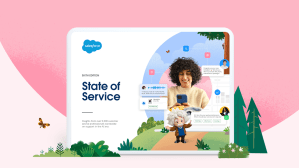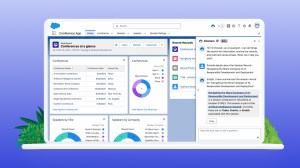What can companies do when growth stalls or an entirely new approach to doing business is called for? They can improve their Growth IQ, writes Tiffani Bova, Salesforce’s Global Customer Growth and Innovation Evangelist, in her book Growth IQ: Get Smarter About the Choices that Will Make or Break Your Business. The book, a Wall Street Journal bestseller, posits that the right combination and sequence of actions will often work best for a particular company’s growth, rather than seeking a single, silver bullet.
Bova has decades of experience working with customers on addressing growth issues and mapping out their futures. Prior to her role at Salesforce, she was Vice President, Distinguished Analyst and Research Fellow at Gartner, Inc. where she specialized in the development of sales strategies, such as channel program development and optimization, go-to-market transformation, and the impact that the cloud will have on traditional sales initiatives. In the interview below Bova discusses her role at Salesforce and her book.
What do you do at Salesforce?
I get the opportunity to travel around the world and meet with customers and executives from many different industries to talk about how they are transforming their sales, marketing and customer service organizations in order to better serve customers. The conversations are a window into the impact of Fourth Industrial Revolution technologies such as AI, strategies for digital transformation and increasing customer expectations for more unified, personalized experiences with brands. The insights I am able to gather are invaluable to what I do here at Salesforce, which is evangelizing the art of the possible. With this unique perspective I am able to share how other companies have driven growth in spite of the increased competitive landscape.
What attracted you to come to the company?
There were a few reasons I was attracted to joining Salesforce. Even though over the years I had attended thousands of conferences, my attendance at 10 years of Dreamforce events always stood out for me.
It was really the only event that I ever attended where when I left I felt like I wanted to be a better person. I was at a point in my career where giving back was something I wanted to do more of. With its 1-1-1 corporate philanthropic model and involvement in issues such as public education and sustainability, I knew Salesforce would give me the opportunity to get involved in giving back.
Beyond that, I wanted to continue working with companies to help them transform the way they pursued growth. Looking at it from the outside as an analyst was only going to allow me to get so close to the realities of the business. With Salesforce’s leading Customer Success platform I knew I could really expand my perspective beyond technology companies into other industries that were blazing new trails. And finally, my previous work on the future of sales was also an area I wanted to continue to research and explore. The Salesforce ecosystem is so vast, with so many amazing customers, there is an endless supply of new things to learn.
You interface with customers a lot. What do you they tell you about the challenges they face and what they need from technology?
My conversations often center around a couple of themes. One is that customers often confuse technology with the ‘end-all-be-all’ solution, rather than seeing it as an enabler to do things differently. They will say that they deployed a particular tool and that they continue to have the same issues or see little improvement to performance. They often don’t see that the particular technology tool is just part of an overall set of changes that they need to make and that the people and process side of deploying new technology solutions holds the key to realizing value and return on their investments.
I like to say that at Salesforce, we don’t only sell technology, we sell change. Change is hard. I also often hear that customers have a utilization problem. For example, perhaps they deployed Sales Cloud, but people in sales aren’t logging in. I emphasize for them that if there is not a cultural shift toward focusing on the overall customer experience, new customer-facing metrics and KPIs to increase cross-functional collaboration, technology can’t necessarily drive positive change on its own.
Your book focuses on 10 growth paths. How did you arrive at these?
Challenges to growth have multiplied. I wanted to present an approach to growth that was digestible. I did not want to dictate “here are 175 ways to grow,” which would overwhelm the reader. I ended up reading at least 100 business books over the course of two years looking for what hadn’t been said yet. I spoke with hundreds of executives around the globe.
This brought me to 10 defined paths to growth. Through that entire process, I was mindful of what has already been said. There was no reason for me to reinvent the wheel, but I believed there was enough change in technology, customers and global commerce that a modernized approach to growth was necessary. The growth paths won’t be unfamiliar to many, which was the point. The underlying concept of Growth IQ has everything to do with the combination and sequence with which companies actually pursue and deploy the growth paths.
How do you figure out which kind of company is best matched for a particular type of growth path?
Too many companies ‘benchmark’ their company against the rival or set of competitors in the same industry. While benchmarking can be a worthwhile exercise, it can also lend itself to a limited view of what is happening in the overall market. This is a key point. In developing the book and the approaches to growth paths, I started with widening the lens to look at overall market context. By starting there, companies can look for best practices from other sectors and think differently about how to solve their particular challenges. Growth strategy is a thinking game. And looking beyond the obvious helped me find amazing stories of success with so many different brands. I tried to avoid using, say, just tech companies.
The ten growth paths shed valuable light across industries, and they were created with that in mind. What companies can do is look at all of these paths and ask ‘what can I learn from them?’ In many cases, companies can benefit from combining growth paths rather than locking onto just one.
Does the book provide examples of specific companies that have found success with these approaches?
In writing the book, I looked at so many companies that had experienced amazing growth, hit growth stalls, and and then recovered or were realizing that the market had changed and they had to change along with it. In many ways I was like an anthropologist, deconstructing what companies had done during a specific point in time. Some of the best material in the book provides the particular combination and sequence of actions that companies took to accelerate growth or recover.
What are the most frequent mistakes companies make in pursuing growth?
This is where the concept of combining growth paths is important. Many companies conclude that their growth stall is due to one thing. The truth is, it’s never one thing. I sit with many people at companies who say, “we’re going to deploy the following technology tool and that will fix the problem.” But have they considered the shift in mindset that must accompany that deployment, or how they need to change existing processes to succeed? The tendency to think that there is one quick fix is very common, and not the right approach.
As you read the 100 business books that help shape your thinking, some must have stood out. Which books most inspired you?
There are several. One that I constantly reference is Purple Cow, by Seth Godin. It explores how companies can stand out. With all the noise out there, it’s hard to stand out.
I also really like Made to Stick by Chip and Dan Heath. It explores ideas that stick and how to come up with them. And I have to mention Emotional Intelligence 2.0 by Travis Bradberry and Jean Greaves, which delves into the “EQ” side of business, not just the IQ side, as well as The Excellence Dividend by Tom Peters, which I love for its exploration of operational excellence in business. There are just too many to mention, but I always can tell what I thought of a book based on how many notes I have in the margins, how much I have highlighted key points and if I actually adopted a concept into my day-to-day thinking.
Editor’s Note: Don’t miss Tiffani Bova’s Salesforce blog post Navigating the Power Shift with AI, Sales, and Customer Relationships















